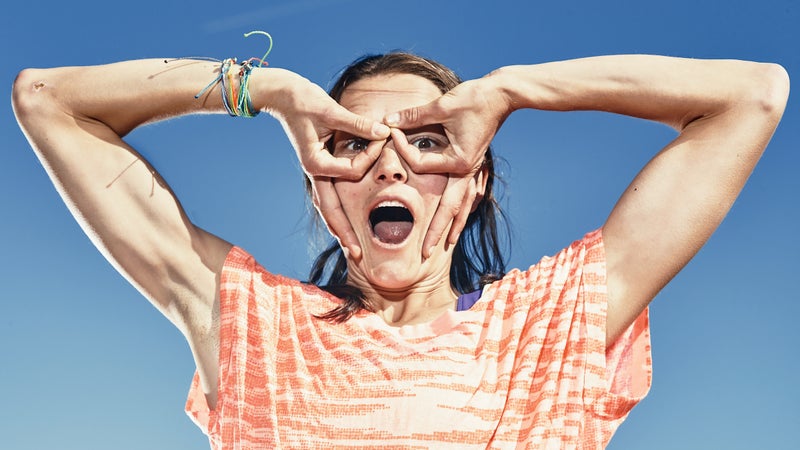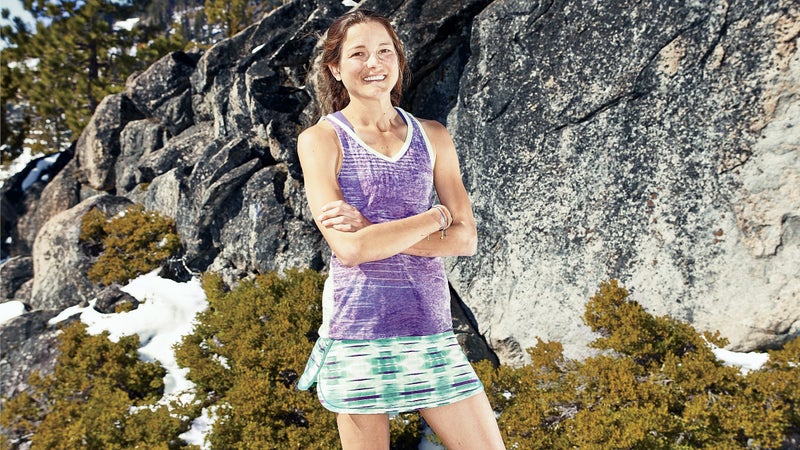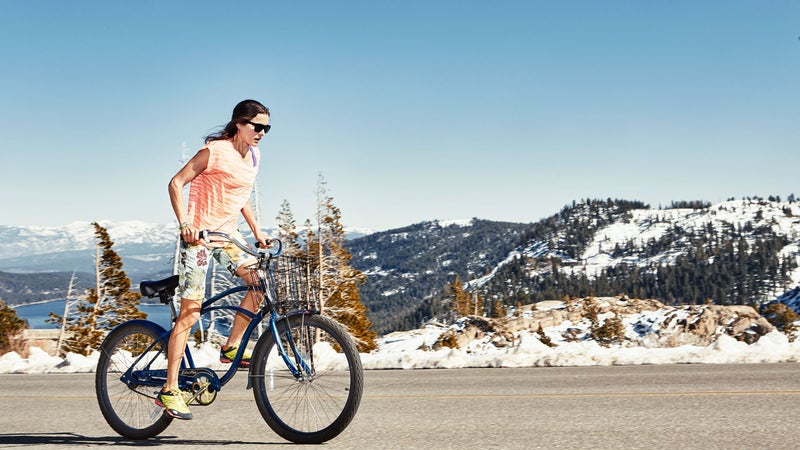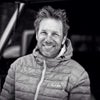Rory Bosio Doesn’t Really Train
In the grueling world of ultrarunning, she's an anomaly: a low-key athlete who thrives on unstructured training, competes by instinct, and crushes men in the sport's most prestigious race
Heading out the door? Read this article on the Outside app available now on iOS devices for members! Download the app.
When Rory Bosio, a 29-year-old pediatric intensive-care nurse from Truckee, California, lined up at the start of Chamonix’s Ultra-Trail du Mont-Blanc in August 2013, she didn’t expect to win.
She had finished fourth in the women’s division the year before, on a snow-shortened 62-mile course. She had never won a major race, and to the small but tough field of women starting in 2013—like Catalonians Núria Picas and Emma Roca, top finishers in the Skyrunner World Series and the Marathon des Sables, respectively—Bosio was all but unknown.
No ultramarathon is easy, but among the growing inventory of 100-milers, the UTMB is particularly fierce. A 104-mile loop that circumnavigates the 15,771-foot Mont Blanc massif, passing through France, Italy, and Switzerland, the route requires ten climbs that total some 31,500 vertical feet. The weather can be so bad, the course is sometimes rerouted or truncated at the last minute. Top times are just over 20 hours, but around half of the 2,300 racers don’t finish at all. Hal Koerner, winner of both the Hardrock 100 and the Western States 100, arguably the two most challenging ultras on U.S. soil, has completed the UTMB only once in three attempts. The year he did finish, 2011, it took him 40 hours and required him to wrap a ziplock bag around his testicles to guard against chafing.
“I put in a lot of volume but not much intensity,” Bosio says. “Sometimes I see what other people are doing and it seems”—her brow furrows—“excessive.”
The lead pack at the 2013 UTMB took off at blistering, road-marathon speeds. At mile 20, Bosio was in about 100th place, but by the midway point she had reeled in all the women and most of the men. On the final climb, a 2,000-foot grind over the Col des Montets, the pace was taking its toll. “It’s the most painful part of the race,” Bosio says. “It felt like a thousand tiny knives were stabbing into my quads.”
At last she came striding through Chamonix, wearing a mud-stained shirt and the North Face’s Eat My Dust running skirt, the streets bracketed with a cheering crowd, like a stage finish at the Tour de France. She crossed the line in 22:37, demolishing the women’s record of 24:56, set in 2009 by American Krissy Moehl. Picas, who would finish second, was nearly two hours back. What’s more, Bosio had come in seventh overall, shaking up the UTMB boys club by becoming the first woman to crack the top ten.
She was quickly beset by reporters: What had she done to prepare? What was the race like? How had she pulled this off? Literally overnight, the American underdog had run her way to international stardom.
To understand the free-spirited enigma that is Rory Bosio, you must first catch up with her, which is no small feat on the trail—or off. Attempt number one: “I’d love to talk, but it’s Samoan Night. I’m breaking out the grass skirt and ukulele! Can I call you tomorrow?” Attempt number two: “Apologies for not responding sooner. Was playing an endless game of laser tag. I can talk tomorrow between 2-4!” Attempt number three: “Sacre bleu! Sorry for missing the call… got roped into an all-day family hike. I’m around tomorrow. Promises, promises!”
“I don’t really train,” Bosio tells me with a laugh when I finally meet up with her at her creekside home in Truckee. “I put in a lot of volume but not much intensity. Sometimes I see what other people are doing and it seems”—her brow furrows—“excessive.”
Despite “not training,” Bosio, now 30, has owned nearly everything she’s entered since 2013’s UTMB. In May 2014, she won the North Face Endurance Challenge New York, a competitive 50-miler. That June, she won the North Face Lavaredo Ultra Trail, a 118-kilometer race in the Italian Dolomites, setting a new course record. And last August, she defended her women’s title at UTMB, dispelling any mutterings that her first win had been a fluke, finishing in 23:23.
The question, of course, is: what mysterious alchemy of genetics and conditioning has given rise to such domination by a woman who paints polka dots on her shoes?

Bosio (pronounced “bo-zee-oh”) is five foot eight, cheery, and very pretty, with broad shoulders and startlingly long legs that eat up mountain trails, one of her biomechanical advantages. She grew up in nearby Tahoe City and spent much of her youth hiking and peak bagging with family and friends around the Sierra Nevada. Bosio discovered that she had a pretty good motor, routinely outpacing the adults. In the winter, she cross-country and downhill skied (Julia Mancuso was one of her closest childhood friends), and during high school she focused her athletic energy on nordic racing.
In 2007, just out of college at the University of California at Davis, she ran her first ultra—the Silver State 50/50, in Reno, Nevada—and killed it, winning the women’s division and placing fourth overall. In 2010, she entered her first 100-miler, Western States, a point-to-point course that starts in Squaw Valley and ends in Auburn, California. Bosio finished fourth. She was promptly recruited to the North Face’s national ultrarunning team (no salary, just swag and travel expenses for races) and ramped up her training in 2011.
That’s when Bosio, who tends to downplay her competitiveness and accomplishments, pushed herself to the breaking point. She had been working with a Zimbabwean coach who steadily increased the volume and intensity of her workouts. He told her she might have a shot at being a competitive marathoner, where the real money and fame could be found.
She had also started her nursing career, working rigorous shifts, occasionally overnight. She found herself getting winded just from walking up stairs. A blood test revealed that she had anemia, with critically low iron levels. Her doctor recommended a blood transfusion.
“I think that first Western States really took a lot out of me,” Bosio says. “I wasn’t paying enough attention to recovery or nutrition back then.”
Bosio retooled her diet, incorporating more iron-rich lean meats and seafood like mussels. She also reached out to Tav Streit, a longtime family friend and endurance athlete. Streit is a sports-performance coach and a licensed physical therapist. He had coached Bosio as a junior nordic skier, and their families vacationed together in Yosemite most summers.
“I gave her a 25 percent chance of racing Western that year,” Streit says. “She could barely walk. What she was doing clearly wasn’t working. We needed to go back to the drawing board.”
Ultrarunning has a notoriously high burnout rate. The volume of racing and training—in some cases 200 miles per week—can be debilitating, sometimes career ending, even to the most dedicated competitors.
“You see something happen after about three years,” says Jenn Shelton, a former American record holder in the 100-mile. “Top runners start to fade away or drop out altogether. That’s about how long it takes for the sport to catch up to you.”
New Zealander Anna Frost, the 2012 World Skyrunner Series champion, disappeared from ultrarunning for nearly a year in 2013 due to injuries and depression. In 2008, Kyle Skaggs, a runner from New Mexico, shattered the course record by two hours at the Hardrock 100. Shortly after, he quit racing.
But Bosio’s troubles may have had some unexpected benefits.
“I had her stop running entirely,” Streit tells me. “We nordic-skied and hiked and talked a lot about the reasons she was running and racing. Rory does really well when she’s psyched on life, so we focused on that. We’d say, What do you need out of today? Let’s turn it into a grand adventure where you’re in the backcountry doing what you love.”
“That was a real turning point for me,” Bosio says. “Training felt less like a chore. It got fun again.”

After a couple of months, Streit helped Bosio with her technique to optimize efficiency over the long haul.
“We shortened her stride quite a bit,” Streit says. He also had her slow down on the uphills, where Bosio’s tendency was to push. At times, Streit waxed Obi-Wan: Focus on what you love about running, the freedom and the ease of it.
The key, Streit insisted, was to find—and remain in—that flow state where you can move along with minimal effort. It’s the holy grail of ultrarunning. “Rory stays in that zone longer than anyone else,” he says. “That’s more important than any exercise prescription.”
Bosio has continued to work with Streit periodically, refining an unorthodox system of racing and training. Because gels, bars, and drink mixes commonly upset her stomach, for example, she invented her own whole-food fueling system. One trail favorite: boiled sweet potatoes mashed with avocado, coconut oil, salt, and other seasonings. “I found these little single-serving pouches online, and I stuff them in my sports bra,” she says.
By the time I catch up with her in Truckee, her workouts have evolved into an enviable buffet of skiing, hiking, yoga, paddleboarding, hula-hooping, dance parties, rides on her beach cruiser, Alejandro, and long walks with her Australian shepherd, Louis. Runs include high-country epics in the Sierra Nevada, without a watch or a training partner, cranking “anything pop” or podcasts like Answer Me This!
“Rory does so well because she’s having a blast out there,” says Hal Koerner. “You see her in races and she’s loving it.”
She spent the six weeks leading up to the 2013 UTMB living in Chamonix, exploring the course, ambling into the Haute-Savoie, stopping at alpine refugios for a cappuccino or a brat and a beer. By the time the race came around, she was fired up and in the zone.

On race day, Bosio hones her focus through a ritualized warm-up that includes applying glitter to her arms, listening to music on her iPod, and performing a series of dynamic exercises like lunges and push-ups. Then, she says, “I have a solo dance party. My style is reminiscent of Elaine from Seinfeld, but more frenetic.” Lastly, she does “a minute or two of calm, deep breathing.”
“When she gets to the start line, she wants to win,” says runner Mike Foote. “Don’t let her tell you otherwise.”
Bosio says she may have one other edge on her competition, courtesy of the night shifts in pediatric intensive care that keep her on her feet until morning. Her work also provides perspective. “Running’s pretty selfish,” she says. “Spend enough time with these kids and you see what really matters.”
While there isn’t much money to be earned winning ultras—race purses are often gear gift certificates—Bosio became a North Face global-team athlete in 2014, which pays enough that she was able to go per diem at the hospital. But it’s not enough to quit her job, even if she wanted to. “I’m conflicted about being a professional runner,” she tells me as we bike around Donner Lake. “I like having a flexible nursing schedule and traveling, but I don’t think I could run full-time. It wouldn’t be good for my mental health.”
Bosio’s 2015 plans are still solidifying, though one thing is certain: she won’t be returning to Chamonix this year. She wants new adventures, she says, and she’s bothered by the fact that UTMB has podium places for ten men but only five women. “When that levels out, I might return.”
Currently, when she’s not out “re-creating the 1960s Olympic downhill at Squaw Valley using saucer sleds,” she has signed on to cohost Boundless, a television show for the Esquire Network about the world’s toughest endurance races. And she’s considering entering La Diagonale des Fous (the Madmen’s Diagonal), a 100-miler with 29,500 feet of climbing held each October on Réunion Island, between Madagascar and Mauritius, that attracts more than 2,000 racers despite its remoteness.
She’d also really like a shot at the Hardrock 100; its long climbs over the San Juan Mountains in southern Colorado are the kind of terrain Bosio loves and dominates. “I could be pretty happy just doing a couple of races each year, and I think that one would suit me well,” says Bosio.
Her fellow runners are less understated. “Hardrock’s tough to get into, since they cap it at 152,” says Foote of the race’s lottery draw. “But if she gets in, look out. She will crush.”


